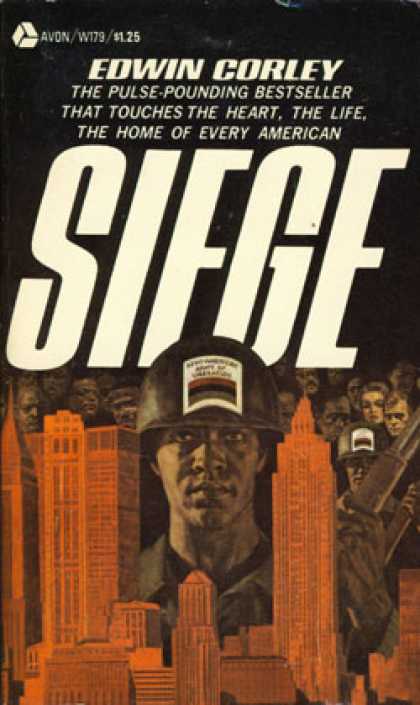 By EDWIN CORLEY (Avon; 1969/70)
By EDWIN CORLEY (Avon; 1969/70)
This novel, a best seller in its day, is a must-read for fans of old school black uprising scenarios* of the type written by scribes like Sam Greenlee and Leroi Jones. Unlike them the author of SIEGE, the late Edwin Corley, was a white man, and the primary intent of his tale being to scare conservative readers. The subject? A full-scale revolution by a highly trained black army that, in contrast to those of Greenlee and Jones, is actually successful.
The protagonist is General Stanley Shawcross, a black ‘Nam vet who becomes radicalized after his wife and children are killed in a car accident, allegedly staged by white supremacists. Shawcross joins up with William Gray, a militant black activist, to hit back at America’s white power structure. Their plan: to take over New York City and eventually turn New Jersey into an all-black enclave. Much of the novel consists of the planning and preparation for the siege, which involves the formation of a vast army, underworld deals and the siphoning of money from foreign nations sympathetic to Shawcross and Grey’s aims.
The book’s packaging makes clear that SIEGE was intended to “Tell It Like It Might Be”—or, as the author writes in his opening disclaimer: “the story that follows may yet, in one form or another, take place.” Pretty outrageous claims, even without the benefit of hindsight!
The idea that Shawcross and Gray are able to train an army of thousands and infiltrate the government without anyone in authority ever finding out is a bit difficult to swallow. Likewise the titular siege, which involves the destruction of NYC’s bridges and tunnels, and is summed up thusly: “From start to finish, the isolation of Manhattan had taken exactly twenty-eight minutes.” Who knew it would be that easy?
At least the author’s portrayal of black militancy in the late 1960s rings true. He even layers in some actual historical figures, such as Malcolm X (whose assassination, it’s alleged, was overseen by one of the characters in this novel), to help contextualize his account. The result is a solidly written page-turner that deserves points for ambition, though definitely not for plausibility.
*For further reading check out AFRO-6 by Hank Lopez, which contains a premise nearly identical to that of SIEGE, and SON OF DARKNESS, SON OF LIGHT by John A. Williams, which features a plot to take out NYC in a manner quite similar to that described here.
